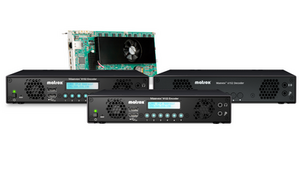News
Do you want to learn more about IPMX but don’t know where to start? Well, you’ve come to the right place. In our IPMX FAQs page, you will learn about the basics of IPMX, how it benefits the AV and Broadcast industries, why it’s important, and more.
In this guide, you will learn about the representation of color in a video setting and the differences between common color models.
SMPTE ST 2110 is a set of standards for professional media over IP networks. The standards define how video, audio, and ancillary data are transported over IP networks in a manner that ensures synchronization and quality of service.
Digital signage is a simple and cost-effective way to reach a large number of customers and employees while increasing sales and enhancing the customer experience. In this article, we explain the three fundamental components needed for successful digital signage.
What is the SRT Protocol? Learn more about SRT and the benefits of using this new protocol.
Encoding refers to converting captured video and/or rendered PC graphics into a digital format that helps facilitate recording, moving, multiplying, sharing, altering, or otherwise manipulating the video content for editing, transport, and viewing.
AV over IP or “Audio-Visual over Internet Protocol” is essentially the transmission of audio-visual data over a network such as a LAN, WAN, or the internet.
Remote production—also referred to as REMI, REMote Integration, or at-home production—is a workflow in which live event content is captured and sent via IP links to a centralized production facility where the final program is produced and distributed. For broadcast engineers, the challenge of REMI isn't just the workflow—it's the transport. Successfully sending multi-camera feeds over public internet requires broadcast encoders capable of ultra-low latency and SRT (Secure Reliable Transport) protocol support. This ensures that your 'at-home' production studio receives frame-accurate, synchronized video, regardless of network fluctuations.
It is an indisputable fact that the AV industry is heading down the path where more signals are transported across IP networks. Achieving reliable, high-quality video and audio distribution over the network is now possible with less bandwidth than ever.
Organizations running critical systems for control or monitoring need a high availability strategy for continuous operation. This strategy puts in place redundancies and failover mechanisms to help them recover quickly in the event of a system failure.










